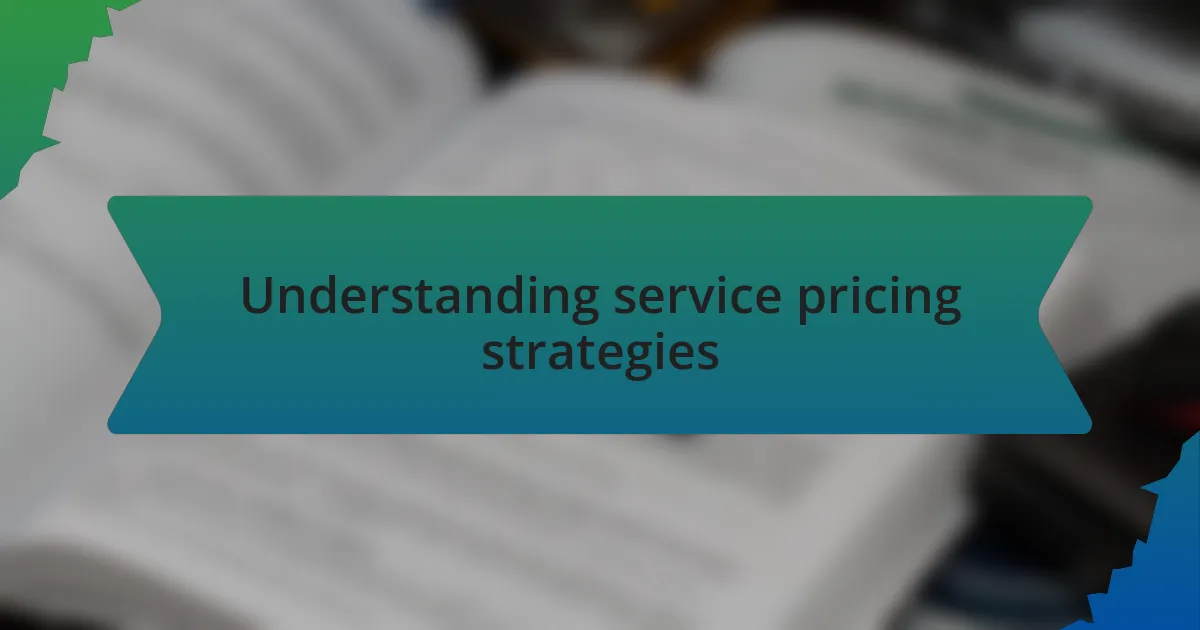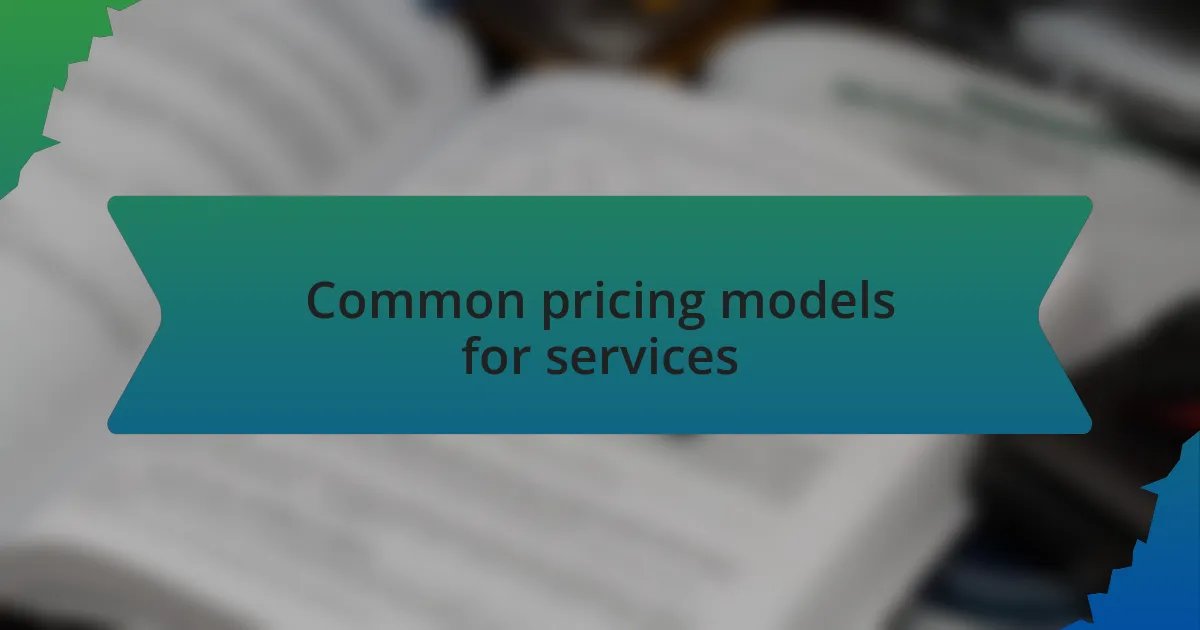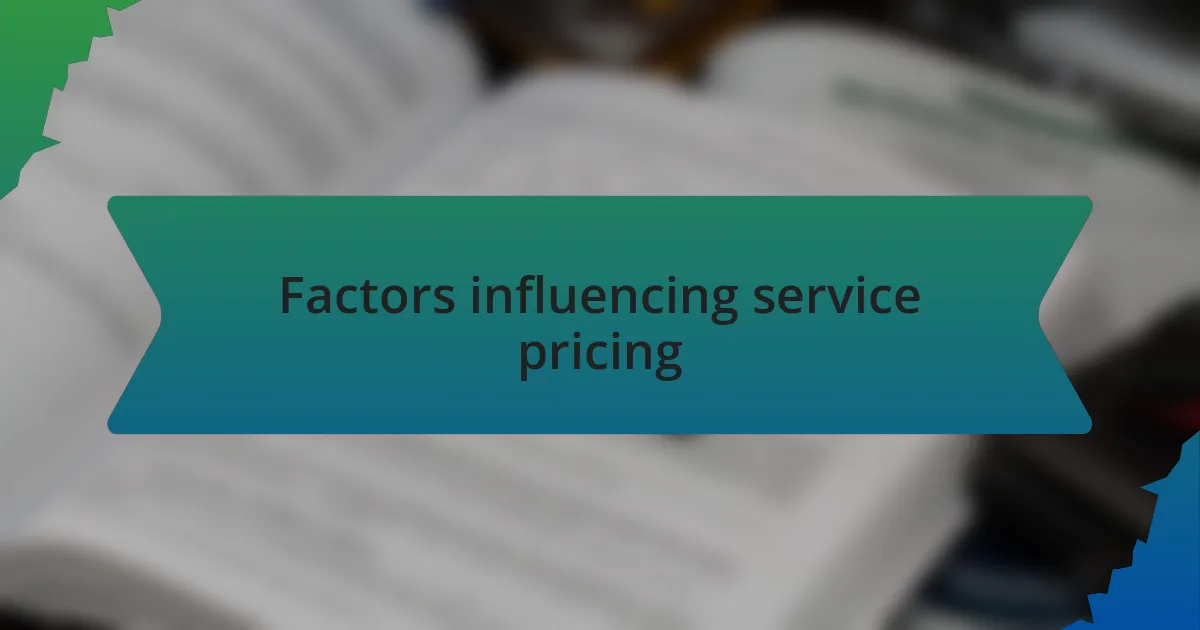Key takeaways:
- Understanding clients’ perception of value is crucial for effective service pricing.
- Implementing tiered pricing and flexible options enhances client engagement and satisfaction.
- Factors like market research, expertise, and client budgets significantly influence pricing strategies.
- Initial low pricing can undermine perceived value; confidence in pricing reflects self-worth.

Understanding service pricing strategies
When I first began pricing my services, I found myself inundated with choices. It was overwhelming to sift through different strategies, like cost-plus pricing or value-based pricing. Have you ever felt that way? I realized that understanding my audience’s perception of value was key to setting a price that not only reflects my expertise but also resonates with my clients.
One striking moment for me was when I tried tiered pricing. I implemented multiple service packages at different price points. It wasn’t just about what I offered; it was about how clients perceived those offerings. I noticed that the more options I provided, the more conversations I had with potential clients about their needs. It was enlightening to discover how much people appreciated the flexibility, and it made me rethink how I structured my services.
Reflecting on my experiences, I learned that it’s not just numbers on a page. It’s about understanding the emotional connection clients have with the services they choose. When I positioned my pricing to emphasize the value and outcomes rather than the service itself, I found that clients were more willing to invest in what I offered. Have you taken the time to consider what truly drives your clients to choose one service over another? It might just reshape how you think about your pricing strategy.

Common pricing models for services
When exploring common pricing models for services, I found that hourly rates are one of the most straightforward approaches. At first, I hesitated about charging by the hour, worried it might undermine the perceived value of my work. However, I quickly learned that this model can work well when clients appreciate transparency and know exactly what they’re paying for in terms of time and effort.
Another model that truly resonated with me was value-based pricing. Instead of tying my price to hours worked, I connected my fees to the outcomes clients achieved. I recall a project where I helped a client boost their engagement significantly, and instead of charging a flat fee, I based my price on the results we achieved together. It felt empowering to base my fees on the value I delivered, and it made the conversation with clients about pricing feel much more collaborative.
Finally, retainer agreements opened up a new dimension for my services. Initially, I approached retainers with some skepticism, concerned they might limit my flexibility. However, after I established a monthly retainer with a client, I discovered the benefits were twofold: it provided me with consistent income, and it allowed me to deeply understand their ongoing needs. Have you considered how a retainer could benefit not only your business but also your ability to forge stronger relationships with your clients?

Factors influencing service pricing
When I first began setting prices for my services, I quickly realized that market research was essential. Understanding what competitors charge for similar offerings helped me gauge my positioning. I still remember conducting a simple survey of local freelancers and noting the range of prices. It made me think – how do I want to differentiate myself in this space?
Another factor that shaped my pricing was my own expertise and experience level. As I invested in professional development, I felt more confident raising my rates. I had a moment of reflection after attending a workshop that deepened my skills, and it struck me: shouldn’t my pricing reflect the value and knowledge I bring to the table? Clients are often willing to pay more for someone who truly understands their industry and can offer unique insights.
Lastly, I found that client budgets played a crucial role in my pricing strategy. I had a client once who expressed delight in my work but was upfront about their limited budget. That conversation made me reconsider some of my packages. I learned that being flexible in pricing could foster relationships rather than hinder them. How can adjusting my services to meet clients where they are financially create a win-win scenario for both parties?

My initial pricing experiences
My initial pricing experiences were quite the journey. I vividly recall my first time setting a price for a service; it felt daunting. I priced my work so low, thinking it would attract clients, but instead, it often left me feeling undervalued. Did I truly think I was worth that little? I learned that pricing is a reflection of self-worth, and the initial low rates didn’t inspire confidence in potential clients.
As I navigated through these early days, I faced a significant moment that reshaped my approach. A fellow freelancer boldly shared their rates during a casual chat, and I was shocked to discover how much more they charged than I did for similar services. It was like a lightbulb went off. I realized this was about more than just competition; it was about owning my expertise and not being afraid to ask for what I deserved.
The emotional rollercoaster of this process can’t be understated. Each time I adjusted my prices, I felt a mix of fear and excitement, wondering how clients would react. In one instance, I hesitated to raise my rates, fearing I might lose a loyal client. Surprisingly, they appreciated my transparency and encouraged me to value my work more. That experience taught me the power of open communication in pricing decisions. Isn’t it interesting how our perceptions of value can evolve over time?